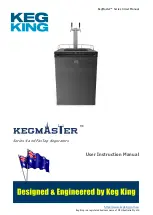
When the steam ceases to flow through a turbine, the cooling of the turbine blades will
disappear. Now, it is not possible to remove all heat generated by the windage losses.
Instead, the heat will increase the temperature in the steam turbine and especially of the
blades. When a steam turbine rotates without steam supply, the electric power
consumption will be about 2% of rated power. Even if the turbine rotates in vacuum, it
will soon become overheated and damaged. The turbine overheats within minutes if the
turbine loses the vacuum.
The critical time to overheating a steam turbine varies from about 0.5 to 30 minutes
depending on the type of turbine. A high-pressure turbine with small and thin blades
will become overheated more easily than a low-pressure turbine with long and heavy
blades. The conditions vary from turbine to turbine and it is necessary to ask the
turbine manufacturer in each case.
Power to the power plant auxiliaries may come from a station service transformer
connected to the secondary side of the step-up transformer. Power may also come from
a start-up service transformer connected to the external network. One has to design the
reverse power protection so that it can detect reverse power independent of the flow of
power to the power plant auxiliaries.
Hydro turbines tolerate reverse power much better than steam turbines do. Only
Kaplan turbine and bulb turbines may suffer from reverse power. There is a risk that
the turbine runner moves axially and touches stationary parts. They are not always
strong enough to withstand the associated stresses.
Ice and snow may block the intake when the outdoor temperature falls far below zero.
Branches and leaves may also block the trash gates. A complete blockage of the intake
may cause cavitations. The risk for damages to hydro turbines can justify reverse
power protection in unattended plants.
A hydro turbine that rotates in water with closed wicket gates will draw electric power
from the rest of the power system. This power will be about 10% of the rated power. If
there is only air in the hydro turbine, the power demand will fall to about 3%.
Diesel engines should have reverse power protection. The generator will take about
15% of its rated power or more from the system. A stiff engine may require perhaps
25% of the rated power to motor it. An engine that is good run in might need no more
than 5%. It is necessary to obtain information from the engine manufacturer and to
measure the reverse power during commissioning.
Gas turbines usually do not require reverse power protection.
Figure
illustrates the reverse power protection with underpower protection and with
overpower protection. The underpower protection gives a higher margin and should
provide better dependability. On the other hand, the risk for unwanted operation
immediately after synchronization may be higher. One should set the underpower
1MRK 511 401-UUS A
Section 8
Current protection
Bay control REC670 2.2 ANSI
215
Application manual
Содержание Relion REC670
Страница 1: ...RELION 670 SERIES Bay control REC670 Version 2 2 ANSI Application manual ...
Страница 2: ......
Страница 26: ...20 ...
Страница 42: ...36 ...
Страница 96: ...90 ...
Страница 274: ...268 ...
Страница 292: ...286 ...
Страница 298: ...292 ...
Страница 308: ...302 ...
Страница 470: ...464 ...
Страница 514: ...508 ...
Страница 608: ...602 ...
Страница 646: ...640 ...
Страница 656: ...650 ...
Страница 657: ...651 ...















































